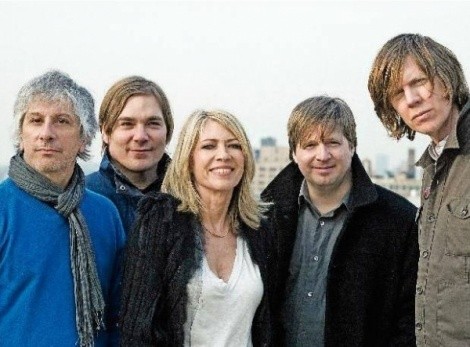
Sonic Youth has been, more
than any other musical
group, known to be
always looking for that perfect
sound. The thing is, their idea
of what is perfect—in the sonic
or philosophical sense (or even
“pretty”)—is different from that
of most conventional rock bands.
Founded in 1981 in New York City
in the artsy, dissonant no-wave
reaction to the punk-rock movement,
their name fit perfectly:
always experimenting sonically,
never academic but always brash,
with a youthful exuberance that
matched the energy of young indie listeners.
As any band with extended longevity, their history
didn’t follow a strictly linear path. They started out on
Homestead and SST, two of the earliest indie labels, releasing
songs inspired by the psychedelic ’60s, serial killers and
cults like the Manson Family. “Kill Your Idols” sounds like
it could be a version of “If you meet the Buddha in the road,
kill him,” or some Eastern spiritual philosophical teaching.
Sonic Youth is in many ways larger than their sound.
Growing in popularity with the rise of alternative rock,
by the ’90s they signed to major label Geffen. The signing
helped introduce them to a whole new audience (the grunge
crowd), but their releases during the period started to
sound more commercial, and the essence of Sonic Youth felt
a little watered-down. After 9/11, several releases including
Murray Street and New York City Ghosts and Flowers served
to work through the difficult emotions of the period, in the
process creating some incredibly beautiful, contemplative
works, some stunning in their relative quietude. During this
time, the band also released some much more experimental
works on their label, Sonic Youth Records (SYR).
The last few releases, Sonic Nurse and Rather Ripped (2006), saw the band return to conventional songwriting format, with somewhat mixed results. At that point, they were trying to reconcile what they had learned during the sonic sojourns of the early 2000s with the energetic punk riffs that were their center. Last year, they marked the 20th anniversary of the release of Daydream Nation—a work that’s on many critics’ lists as one of the best indie albums of all time—with a tour in which they played the entire album. It was a moment that needed to be noted, but still felt like a breathing space before whatever would come next.
Their latest release, The Eternal, is a coming full circle
in many ways: most obviously, a return to their roots at an
indie label with Matador (founded by former Homestead
capo Gerard Cosloy along with Chris Lombardi), and they
found the change creatively liberating. It also reprises a
lot of themes, lyrically, sonically and even historically, that
have shaped the band over 28 years. To some of their new
listeners, who weren’t even born when the band started
making music, they still manage to sound innovative and
electric—and, perhaps most importantly, they sound cool.
As one of the bands that, as the saying goes, listened to the
Velvet Underground and started a band, they copped that
group’s New York attitude, having a kind of aura about them.
Their artiness has extended to cover art by Gerhard Richter
(Daydream Nation) and dazzling painting on The Eternal by
folk artist John Fahey.
Right out of the gates on “Sacred Trickster” they let you
know what you’re in for with the clashing opening guitar
notes rising into a wicked rhythmic riff and wall of sound,
finally Kim Gordon’s wish “I want you to levitate me,”
somehow including in just over two minutes nods to French
painter Yves Klein and noise band Noise Nomads. “I wish
I could be/music on a tree,” she emotes, and among other
things, this album allows the band to delve into explorations
of wish fulfillment like they haven’t for quite sometime.
There has always been an overt sexuality in Sonic Youth’s
music, and “Malibu Gas Station” they say is “an ode to the
flash moment of the camera as you knowingly step from
your SUV sans panties.” Yet, sex is never just sex in their
music, whether in the early din of “Confusion Is Sex” or
this record’s “Anti Orgasm,” inspired by ’60s Berlin model/activist Uschi Obermeier and the relationship of free love to
the somewhat chaotic leftist uprisings of the ’60s.
Their affection for ’60s hippie and beatnik figures is
expressed in “Leaky Lifeboat (for Gregory Corso).” The
reference by Beat poet Corso to life on Earth as a “leaky
lifeboat” is a pointed one about the state of the planet environmentally.
“Calming the Snake” refers to musical progenitors
the MC5, as well as ’80s contemporaries The Dead C
and Neu. “Poison Arrow” is dedicated to the picturesque yet
still experimentally daring music of Kevin Ayers.
“The record is our celebration of new-found freedom,”
explains singer/guitarist Thurston Moore. After numerous
albums filled with sonic contemplation and melancholy, here
is an album that really feels like a celebration of sound.
SONIC YOUTH
w/ Awesome Color
Gallivan Center
239 S. Main
Thursday, July 30
7 p.m.